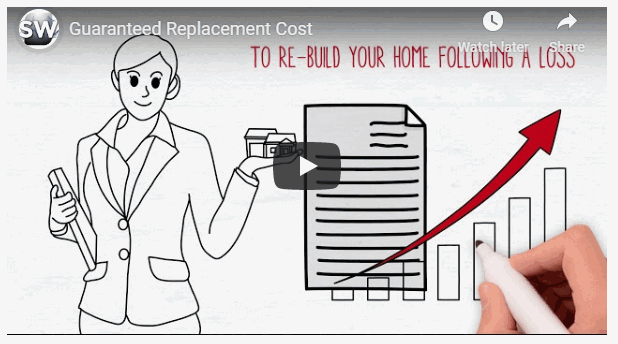Have you been shopping around for home or property insurance? Then you may have already come across the term “replacement cost.” You would think that replacement cost means the cost to replace your home exactly like it was. Unfortunately, these words can be twisted to mean something different so you need to know all the variations.
As any home insurance advisor will tell you, the most critical part of a homeowner’s insurance policy is the dwelling coverage, which insures the home itself. In case of fire and other covered perils, a dwelling coverage claim will typically pay or reimburse you for the cost of repairing or rebuilding your home, but only up to the coverage limit of your policy.
Actual Cash Value vs. Replacement Cost Value
Homeowners typically have two options when choosing the amount and level of protection of their insurance policy. There’s ACV or actual cash value and RCV or replacement cost value. ACV will reimburse you based on the initial cost of your home, depreciation considered, which means the insurance coverage may decrease over time. RCV, on the other hand, insures your home for its current market value, regardless of any potential depreciation.
Of the two, replacement cost valuation is the safer choice. But what many homeowners often fail to realize is that a standard replacement coverage may not be enough. The cost of labor and building materials are likely to rise in a few years due to inflation and market volatility. Thus, the cost of rebuilding a home back to its original state can very well go beyond the limits of your standard RCV dwelling coverage. This is where extended replacement and guaranteed replacement coverage come in.
Extended Replacement Cost Coverage
The replacement cost of a home or property is not determined by its market assessed value but by how much it costs to rebuild the structure at the time of the insurance purchase. That said, endorsing a standard replacement coverage to extended replacement cost increases or extends the limit of your dwelling coverage.
Simply put, extended replacement cost coverage is like upgrading your standard RCV claim settlement terms. Most insurers will allow you to increase your coverage anywhere between 25% to 50% of your dwelling coverage limit.
Say, for example, your home has a standard replacement cost of $200,000. A few years later, a fire burns the whole place to the ground. But because construction and labor costs have since skyrocketed, it now costs $250,000 to rebuild your home, which leaves you with a $50,000 deficit that you’re likely to pay out-of-pocket.
With extended replacement cost, you won’t have to pay anything in that situation. A 25% increase in your dwelling coverage will automatically entitle you to $250,000 in rebuilding costs. Your insurance provider will pay for the repair or reconstruction expenses even if the loss amounts to more than your initial dwelling coverage policy limits.
Guaranteed Replacement Cost Coverage
If extended replacement coverage upgrades your dwelling coverage to up to a certain percentage over the policy limit, guaranteed replacement cost takes things to an entirely different level.
“Guaranteed” being the operative word here, a guaranteed replacement cost coverage will reimburse you for whatever it costs to rebuild your home, regardless of your home’s value or the limit of your dwelling coverage. Even if it takes $400,000 to rebuild the same $200,000 home after a covered loss, your insurer will cover every extra dollar. There is no cap in the amount that the insurance company is obligated to spend to restore the place to its original condition.
Of the different home and property insurance options available, guaranteed replacement coverage provides the best protection. It is meant to provide homeowners with warranted security in a world of fluctuating rebuilding costs.
But while guaranteed RCV makes for an excellent and reliable financial safety net for when a disaster or unexpected events strike, it is not without disadvantages. Aside from the significantly higher premiums, there are not many insurers that offer this option. If you have the resources to afford it, though, the “guaranteed” coverage and peace of mind are more than worth it.
Choosing the Right Coverage
Whether you opt to go for one or the other, it pays to have additional insurance on your home – especially if you live in disaster-prone areas. Keep in mind, though, that these endorsements are only meant to safeguard you against rising construction costs following a devastating covered loss. You cannot use it to add square footage or a new wing to your home that was not there before the incident.
To learn more about these upgrades, and determine the appropriate level of insurance protection for your home and belongings, get in touch with a reliable insurance provider near you.
You might also like:
- Cutting Your Home Insurance Bill: Three Secrets That Can Save You A Bundle
- Hurricane! How to Get Compensation after Significant Home Damage
- Legal Liability: What Exactly Does Your Home Insurance Cover?
- 4 Tips to Lower Your Homeowners Insurance Costs
About the Author
Rachael Harper is the Content Marketing Strategist of Bennett & Porter, a wealth management and insurance firm based in Scottsdale, Arizona. When not writing, she makes use of her time reading books and bowling with her family and friends.




